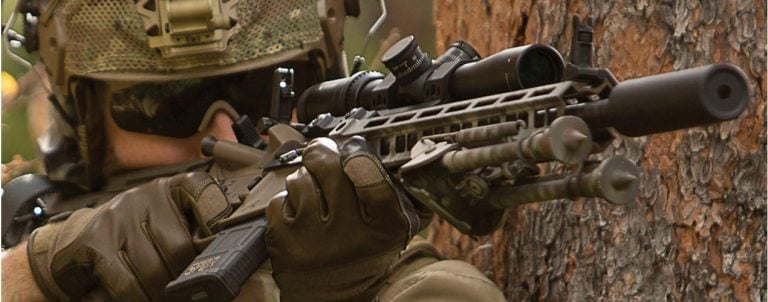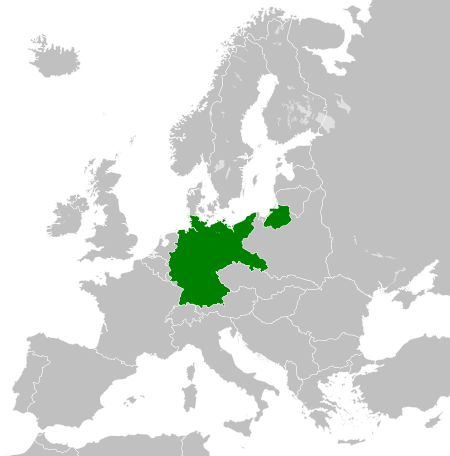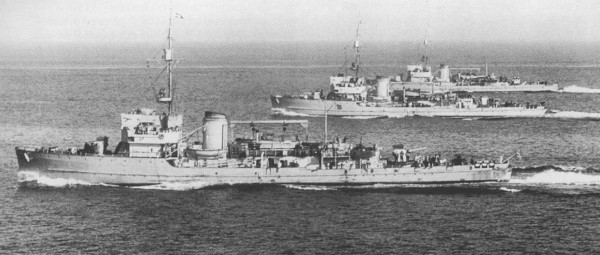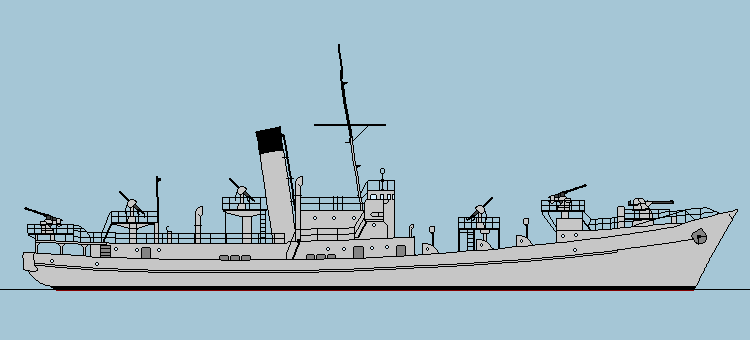.
... or not appreciated appropriately so far (mostly infantry stuff).
45° mounted iron sights with straight buttstock rifles
multi-spectral 'smoke'
Infrared sensors ("thermal" sensors, mid and far infrared spectrum) can see through ordinary smoke such as HC smoke. White phosphorous smoke is an unsatisfactory concealment as well. Multispectral smoke has been developed as remedy, it does obscure in the infrared spectrum, albeit the duration of this concealment is still somewhat short. IR SMK munitions are till relatively new (multispectral smoke came up for real in the late 90's AFAIK) and were not really high priority in the last two decades when Western armies were more concerned about beating up or suppressing resistance by opposition that had close to zero thermal sensors. I have no knowledge about the inventories, but I strongly suspect that we have much too few IR SMK munitions in our depots.
Another possibility is to not expend smoke munitions, but to use reusable smoke generators. The M56 vehicle and M58 vehicle are claimed to be able to provide 90 min visual obscuration and 30 min thermal + millimetre wavelength obscuration.
HC, WP or simple evaporated diesel fuel isn't good enough as obscurant on the battlefield any more. You need dedicated consumables that have fibres (often carbon fibres/graphite) and other stuff suspended in the air to block modern sensors.
video of a naval example:
infrared illumination
Another novelty are infrared illumination (IR ILLUM) munitions. Modern low light night sights use the near-infrared spectrum (not really thermal sights), but they are merely intensifying (by a factor of a couple ten thousand times). So they depend on having at least some light source (whereas the objects themselves are the radiation source with mid and far IR "thermal" sights). Early generation low level sights thus needed some infrared flashlight (often seen on 1960's tank photos, first tank-mounted application: 1, 2), as do present-time children night vision toys. The moon and stars usually provide enough light, but they don't through dense clouds or during new moon. That's when IR ILLUM can help out and give the low light sensors the needed light. IR ILLUM munitions work like normal ILLUM munitions, but are hardly visible to the naked eye. Finally, digital camera-like low light vision doesn't have the extreme intensification of the other dedicated low light technology, but digital cameras can see even colours at night if only there's enough light. "Enough" light may still be black to the naked eye, of course. Another advantage of digital cameras as low light sensors is that they are incredibly cheap by comparison. So IR ILLUM munitions and the old school illumination lights (which don't need to be mounted on your weapon or vehicle, they could also be thrown) could team up for an affordable night vision combo.
example https://dn-defence.com/rgw-90/rgw90-illum-2/?lang=en
intra-squad radios
Radios had trickled down to platoon level by the Second World War and squad level by the Vietnam War. Then there was no further progress made until the 1990's, when mobile phones became affordable consumer goods even though police did introduce radios for everyone in the 1980's at the latest. The first generation of intra-squad radios was still quite bulky, but currently available ones are really lightweight (about 300 grams + batteries) and battery demands seem manageable. The quite reliable and secure voice communication inside the infantry, engineer or scout squad is a huge boon for stealth, situational awareness, leadership and morale. Range issues persist inside settlements and wet woodland, of course. The power output and the atmospheric attenuation of the frequencies used makes it very hard to direction find and triangulate such radios from useful distances.
backpack ESM
That being said, backpack radio electronic support measures (radio direction finding, saving and transmitting of readings) are a thing and potentially of great utility. Radio direction finding and triangulation of hostile positions is of value if the hostile emitter doesn't move and can thus be hit with indirect fires, but even more useful is to slowly and steadily build up a situational picture by logging which emitter appears to get answers by which other emitter. This way you might find not only the locations, but you can identify hierarchies and identify company, battalion,, brigade command posts. Battalion and brigade command posts will usually have their emitter about a kilometre away from their actual command post, but the triangulation is a starting point for finding said CP with other means. Later on you can hit all those detected and identified emitters and CPs with a few minutes of artillery fires and the local opposing forces will be limited to individual actions against your following push on the ground.
example www.chemring.com/(...)
backpack ECM
Artillery shells were equipped with radio proximity fuses for the first time in WW2, to enable hits on aircraft with near misses. The same kind of shell could also be used for great fragmentation effect with airbursts a few metres above ground, and this was first done in late 1944 on a battlefield. This threat was countered by the 1960's or so with dedicated jammer vehicles, so few in quantity that they might only be used to protect high value locations such as at forced river crossings. The jammers were finally shrunk to backpack size in the 1990's, and had to be adapted to jam mobile phone connections in the occupation wars 2003ff (as many such mines were fused by mobile phone). Nowadays there are (heavy) ECM backpacks capable of broadband jamming, which includes the jamming of infantry and tank radio communication in less than one kilometre radius. The might -depending on frequency- also be suitable to jam battlefield ground surveillance radars and air/ground attack radars, but this would require adaptation for the corresponding radio bands.
examples:
mctech-jammers.com/products/mc-4-8-ra/
www.intercept.ws/catalog/4542.html
expendable ECM
HEXJAM is a published expendable ECM jammer, suitable to disrupt ground forces tactical radio communication in less than a kilometre radius. The benefit of a stationary expendable jammer over the backpack solution is that you don't need to be concerned about its susceptibility to direction finding and triaggulation, and this is important exactly when such expendable jammers may be practical to employ; in rather static situations. You might have such a jammer emplaced at an ambush site, for example.
https://fas.org/man/dod-101/sys/land/docs/960800-kornuta.htm
DRFM ECM
This is not much of an army technology, but the technology has advanced to a point where tiny decoys can repeat radio frequency signals and thus act as a kind of reactive jammer, creating a false return signal/echo and thus false target. Ground forces can employ much simpler means, such as simple fixed reflectors (90° angle reflector, Luneburg lens) instead. The mentioned repeater decoys may thus be a niche solution for combat aircraft with their specific needs, but who knows, maybe this DRFM tech becomes relevant to ground forces as well. Maybe they could double as expendable radio relays?
IR strobe/beacon
This is super-cheap tech, popularized by the Black Hawk Down movie and available for little money on mail order. Back in the old days ground troops placed flags on the ground to keep friendly aircraft from shooting at them and to give them an orientation where the enemy might be. Nowadays we can do this with IR strobe lights, albeit it's not quite for sure how useful this is when the opposing forces may have low light or thermal sensors as well.
tiny LED flashlights
This is first and foremost civilian technology. I keep seeing big flashlights, and I consider those to be nonsense. Very cheap very small very light LED flashlights provide more brightness than old big flashlights, so we should use the tiny ones. Additionally, everyone who mounts a light on a gun is doing it wrong.
importance of magnifying sights for target ID rather than aiming
Magnifying sights have become very widespread in the past 25 years, nowadays a normal infantry rifleman can expect either a red dot sight or a magnifying sight on his rifle or carbine. Normal infantry can easily make do with 4x magnification. 1.5x magnification as used with some German early WW2 sniper rifles and in the famous Austrian AUG rifle allows for easy use with both eyes open, but this fallen somewhat out of fashion relative to red dot sights without magnification.
Magnifying scopes of 3x to 4x power have a benefit aside from more accurate shots well past 100 metres; they have proved to be even more importantly useful for positive identification of targets. You better don't shoot at everything that moves, for it could be friendlies that move in your field of view. So you often times have to identify what you see before you may shoot, and the magnification helps greatly with this.
The old style was to let the squad leader control the squad's firepower, and the squad leader is supposed to have 15x binoculars for identification. The Americans apparently never fully bought into this disciplined way of shooting in infantry combat, and became particularly endeared with the distributed ID capability that the magnifying scopes offer. This is also a driver behind the use of magnifying scopes on machineguns, even though the machinegunner's firepower should really be directed by the squad leader if the squad is more than a mob.
stripper clips
Stripper clips are ancient stuff, don't really deserve to be called "technology". Still, they seem to be underappreciated as a means to cut down weight.
/2014/10/stripper-clips-and-infantrymans-load.html
captive piston commando mortar
This is another ancient tech, which is in my opinion underappreciated. Commando mortars with less than a km effective range have been highly appreciated by several armies (especially the British Empire/Commonwealth and French armies) for their usefulness. Their usefulness with high explosive (fragmentation) mortar bombs is debatable and highly dependent on the user's skill at the very least, but their usefulness with (IR) ILLUM and (multispectral) SMK munitions should be undisputed. They reach much farther than even 40 mm MV rounds.
The captive piston principle came up in the 1960's and keeps the propellant gasses inside the cartridge case. This eliminates muzzle flash, keeps the weapon quite clean, limits the maximum practical pressure (range), largely keeps the barrel from heating up and minimizes the noise of the (subsonic) shot. Pistols with captive piston munitions really just make a 'click' and repeating sound. 51 mm captive piston commando mortars are as silent as 52 dB at 100 m.
The French use the Belgian FLY-K / JetShot design that's been around for half a century by now. I don't see why anyone should use an ordinary commando mortar instead of a captive piston design. Sure, ordinary munitions are more easily sourced and cheaper, but I prefer the stealth advantage especially for the illumination work. By the way; commando mortars hardly ever use auxiliary charges, so the captive piston design's inability to make use of auxiliary charges is not a factor.
Noise and effect of conventional 51 mm mortar
/2014/12/the-stummelwerfer-and-2b25.html
/2014/04/underrated-french-infantry-arms-and.html
ultralightweight ballistic helmet shell
Helmets are a pain in the ass neck. It should be a no-brainer to keep them lightweight, but weight savings keep getting misused for performance enhancements as with all infantry equipment. The infantryman is thus perpetually overburdened. There are some very lightweight, plentiful protective helmet shells available at much less weight than standard issue helmet shells, though. This should receive more attention.
http://www.armorsource.com/helmets/ljdaire.shtml
decoupled suspension for tracked vehicles
The German Puma infantry fighting vehicle gets much attention for its unmanned turrets, gold-plating, high price and the long time it took to mature. An interesting feature hardly ever gets much attention: The running gear is de-coupled very much reducing vibrations inside and thus reducing the fatigue of its crew and passengers. There's only one other promising approach to have this as far as I know, and that's the (ancient tech) rubber band tracks. Combine both in a under-30 tons vehicle (approx. limit of rubber band track suitability) and you'd have a crew and (in APC or IFV) an infantry squad that's in much better shape when the shit hits the fan.
germanarmor.blogspot.com/2020/04/puma-ifv.html
portable inertial navigation system
Satellite navigation (GPS, Galileo, Glonass) is great and accurate, and depends on geostationary orbit (35,786 km high!) satellites emitting ridiculously weak signals (GPS: 44.8 W with 12 dBi antenna gain). Drowning these signals with jammer emissions is easy for both Russian federation and PR China.
The go-to alternative for accurate navigation without SatNav is a inertial navigation system (INS). This was first used in aircraft in the 1960's and has been miniaturized and lightened tot he point that cheap smartphones have rudimentary INS abilities. Even the more accurate, more expensive accelerometer chips are quite cheap and we could simply give all radios an INS capability and SatNav capability. The INS would continue the navigation between SatNav reception updates or other (possibly manual) location updates.
The talk about military GPS receivers being jam-hardened and so on is physics bullshit in my opinion.
M885A1 EPR
This 5.56x45 mm cartridge was highly publicized and largely laid to rest the debate about whether 5.56 mm is a too weak calibre for dismounted use. Yes, there are still some efforts for an intermediate calibre, but this cartridge solved so many issues that the case for an intermediate cartridge was moved into a 'luxury problems' category.
The lead-free steel-tipped bullet is semi armour-piercing and its loading is so hot (high pressure) with such quick combustion (suitable for short barrels as in M4 carbine) that the performance (deadliness) issue of short barrel 5.56 mm weapons can be considered solved. The quicker combustion is also supposedly reducing muzzle flash (albeit flash hiders work wonders anyway).
The downsides are the the exposed steel tip scratches the weapon and magazines and the hot loading is wearing out guns quicker (and I suppose a few guns may generally be unsafe with this chamber pressure).
.338 Norma Magnum machineguns
The other intermediate calibre debate was less public; the search for a gun between 7.62x51 mm NATO and 12.7x99 mm NATO (.50 BMG). Everything that's armoured against anything is armoured against 7.62x51 mm NATO. The cartridge isn't terribly much respected regarding chewing through walls or sandbag cover, either. I myself was and are a proponent of such an intermediate calibre for vehicle-mounted machineguns (and sniper rifles). The reason is that the 12.7 mm cartridge is overkill for most purposes, the cartridges are terribly bulky and everything that's more hardened than against 7.62NATO is hardened against all but subcalibre 12.7 mm bullets.
It appears that the known sniper rifle calibre .338, more specifically the .338 Norma Magnum, had its breakthrough with an order for USSOCOM. There are two machineguns available for this calibre:
en.wikipedia.org/wiki/Lightweight_Medium_Machine_Gun
tactical-life.com/news/sig-mg-338-machine-gun-first-look/
Sadly, it appears that the order was for dismounted use machineguns. That's horribly wrong in my opinion. It's just one more case of weight savings by technology being misused for performance gain rather than to finally lighten the infantryman's burden. The armed bureaucracies seem unable to appreciate the human component, agility, endurance.
Sound-based sensors
The acoustic sniper detection had a boom in the past two decades, the unattended ground sensors using microphones have been largely ignored (and maybe not much of a success), and the infrasound detection of helicopters (even without line of sight) is outright underappreciated.
defense-and-freedom.blogspot.com/2016/10/acoustic-sensors.html
I'm a proponent of a remotely controlled weapon (.338 machinegun) station on all battlefield ground motor vehicles except motorcycles and Medevac vehicles. Such a RCWS could be an ever-present defence against drones, but this requires sensors. Staring IR sensors plus microphones (doubling for mortar triangulation and sniper detection) could form this sensor package, and fire control would use an additional visual/IR sight with laser rangefinder/Ladar. Acoustic sensors seem underappreciated to me, and this in a very critical spot.
Tracers that don't burn
This https://ammoinc.com/product-category/product-family/streak-ammunition/ is a less intrusive alternative to tracers, and might be suitable for a universal day/night round. A weak glow is all that you need at night, and we don't need tracers in daylight. I doubt that the small cross section and high speed of a 5.56x45 bullet allow for the visual tracer effect in daylight with this technology.
Tracers used to be useful for small unit leaders to communicate where to shoot at, but this seems to be less of an reason with intrasquad radios and it wasn't a universal practice ever, anyway.
This was uncharacteristically hardware-centric, but in part it's a preparation for later posts.
S O
.



.svg/1280px-Flag_of_Weimar_Republic_(jack).svg.png)



